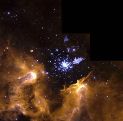-
Available Undergraduate Projects
- Please email me at jennifer.hoffman (at) du.edu for more information about any of these projects.
-
What makes the "winking star" wink?
KH 15D, sometimes called the "winking star," is a young binary star surrounded by a thick wobbling disk that causes peridioc and variable eclipses. I am looking for a student to help analyze data from the McDonald Observatory's 2.7 m telescope that will help us learn more about the characteristics of the disk. For more background on this project, see my KH 15D page. This project would be good for a student with some computing experience and an interest in stellar astronomy.
-
Learn to use a telescope, and help bring an astronomical instrument back to life!
I am working with colleagues nationwide to move an instrument called the HPOL spectropolarimeter from Wisconsin to Arizona, where it will be installed on the Mt. Lemmon Observing Facility. We are interested in training undergraduates in conducting observations with the instrument at the new telescope. Some of these observations will be used to calibrate the instrument and others will be scientific observations of stars and supernovae. This project is best suited for students who would like hands-on experience with astronomical equipment, can travel frequently, and don't mind staying up all night! Travel expenses will be covered.
-
A supernova on your desktop
Students in my computational astrophysics group create 3-D models of the spectral and spectropolarimetric signatures created when light from a supernova explosion interacts with the surrounding gas thrown off by the pre-supernova massive star. No programming experience is required for participation in this group; the work is collaborative and ongoing.
-
3-D simulations of hot star winds
I am beginning a project with a colleague at East Tennessee State University to create three-dimensional computer models of the structure of the stellar winds of very hot, active stars. The shapes these winds create in the circumstellar material surrounding their stars give us clues to the stars' subsequent evolution and ultimate explosion as supernovae. A student with good visualization and programming skills could join this project and learn to create models of different stellar wind geometries.
-
Student Research Results
-
Cosmic Fireworks: When Stars Explode
This poster was presented by Alisha Humphries, Naomi Pequette, and Charee Peters at the 2009 DU Undergraduate Symposium. It presents results from their work with me in simulating Hα line profiles from supernovae with circumstellar material.
